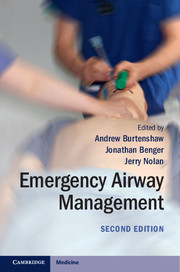Book contents
- Emergency Airway ManagementSecond Edition
- Emergency Airway Management
- Copyright page
- Contents
- Contributors
- Foreword
- Note
- Glossary
- Chapter 1 Introduction
- Chapter 2 Delivery of oxygen
- Chapter 3 Basic airway management
- Chapter 4 Indications for intubation
- Chapter 5 Airway assessment
- Chapter 6 Preparation for rapid sequence induction
- Chapter 7 Pharmacology of emergency airway drugs
- Chapter 8 Rapid sequence induction and tracheal intubation
- Chapter 9 Difficult and failed airway
- Chapter 10 Post-intubation management
- Chapter 11 Emergency airway management in special circumstances
- Chapter 12 Non-invasive ventilatory support
- Chapter 13 Human factors, audit and skills maintenance
- Book part
- Index
- References
Chapter 11 - Emergency airway management in special circumstances
Published online by Cambridge University Press: 05 April 2015
- Emergency Airway ManagementSecond Edition
- Emergency Airway Management
- Copyright page
- Contents
- Contributors
- Foreword
- Note
- Glossary
- Chapter 1 Introduction
- Chapter 2 Delivery of oxygen
- Chapter 3 Basic airway management
- Chapter 4 Indications for intubation
- Chapter 5 Airway assessment
- Chapter 6 Preparation for rapid sequence induction
- Chapter 7 Pharmacology of emergency airway drugs
- Chapter 8 Rapid sequence induction and tracheal intubation
- Chapter 9 Difficult and failed airway
- Chapter 10 Post-intubation management
- Chapter 11 Emergency airway management in special circumstances
- Chapter 12 Non-invasive ventilatory support
- Chapter 13 Human factors, audit and skills maintenance
- Book part
- Index
- References
- Type
- Chapter
- Information
- Emergency Airway Management , pp. 121 - 163Publisher: Cambridge University PressPrint publication year: 2015

